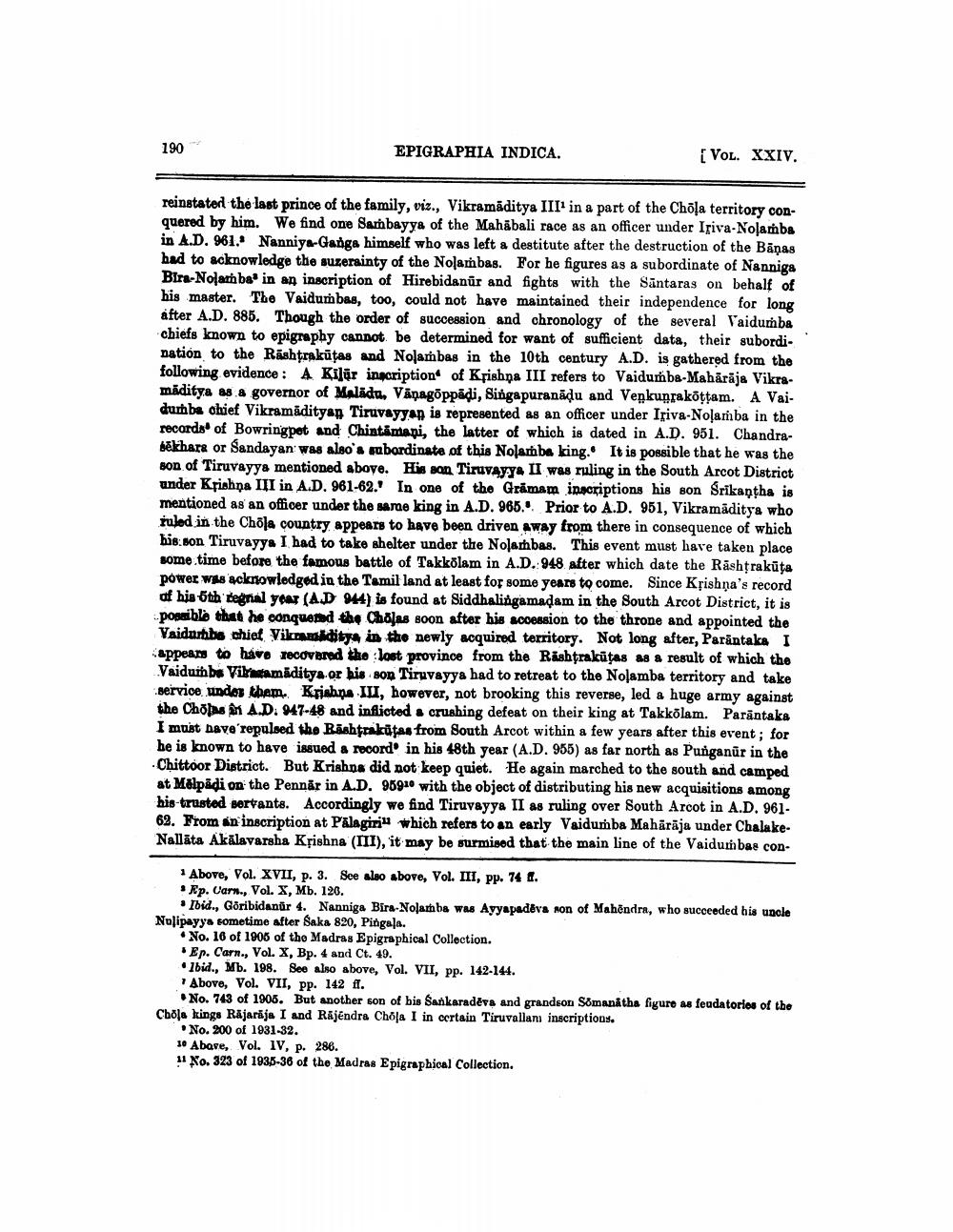________________
190
EPIGRAPHIA INDICA.
[Vol. XXIV.
reinstated the last prince of the family, viz., Vikramāditya III' in a part of the Chola territory conquered by him. We find one Sambayya of the Mahabali race as an officer under Iriva-Nolamba in A.D. 961. Nanniya-Ganga himself who was left a destitute after the destruction of the Bāņas had to acknowledge the suzerainty of the Nolambas. For he figures as a subordinate of Nanniga Bira-Nolamba' in an inscription of Hirebidanúr and fights with the Sāntaras on behalf of his master. The Vaidumbas, too, could not have maintained their independence for long after A.D. 885. Though the order of succession and chronology of the several Vaidumba chiefs known to epigraphy cannot be determined for want of sufficient data, their subordination to the Rashtrakūtas and Nolambas in the 10th century A.D. is gathered from the following evidence: A Kilür ingcription of Krishna III refers to Vaidumba-Mahārāja Vikramáditya as a governor of Maladu, Vanagõppādi, Singapuranādu and Venkunrakottam. A Vaidumba chief Vikramadityan Tiruvayyan is represented as an officer under Iriva-Noļamba in the records of Bowringpet and Chintamani, the latter of which is dated in A.D. 951. Chandrabekhara or Sandayan was also's rubordinate of this Nolamba king. It is possible that he was the son of Tiruvayya mentioned above. His son Tiruvayya II was ruling in the South Arcot District under Krishna III in A.D. 961-62. In one of the Gramam inscriptions his son Srikantha is mentioned as an officer under the same king in A.D. 965. Prior to A.D. 951, Vikramaditya who juled in the Chola country, appears to have been driven away from there in consequence of which his:son Tiruvayya I had to take shelter under the Nolambas. This event must have taken place some time before the famous battle of Takkolam in A.D. 948 after which date the Rashtrakūta power was acknowledged in the Tamil land at least for some years to come. Since Kộishna's record of his 5th regnal Yar (AD 944) is found at siddhalingamadam in the South Arcot District, it is posible that he conquopad the Cholas soon after his accession to the throne and appointed the Vaidurhiba chiot Vikramaditya in the newly acquired territory. Not long after, Parantaka I (appears to have recovered the lost province from the Rishtrakūtas as a result of which the
Vaidumba Vikramaditya or his son Tiruvayya had to retreat to the Nolamba territory and take service under them. Krishna III, however, not brooking this reverse, led a huge army against the Cholas An A.D. 947-48 and inflicted crushing defeat on their king at Takkõlam. Parantaka I must have repulsed the Rashtrakūtas from South Arcot within a few years after this event; for he is known to have issued a record in his 48th year (A.D. 955) as far north as Punganur in the Chittoor District. But Krishna did not keep quiet. He again marched to the south and camped at Malpädi on the Pennar in A.D. 96916 with the object of distributing his new acquisitions among his-trusted servants. Accordingly we find Tiruvayya II as ruling over South Arcot in A.D. 96162. From an inscription at Palagiri' which refers to an early Vaidumba Mahārāja under ChalakeNallāta Akālavarsha Kțishna (III), it may be surmised that the main line of the Vaidumbas con
1 Above, Vol. XVII, p. 3. See sloo above, Vol. III, pp. 74 A.
Rp. Varn., Vol. X, Mb. 120.
• Ibid., Goribidanur 4. Nanniga Bira-Nolamba was Ayyapadeva non of Mahendra, who succeeded his uncle Nolipayya sometime after Saka 820, Pingala.
• No. 16 of 1900 of the Madras Epigraphical Collection. . Ep. Carn., Vol. X, Bp. 4 and Ct. 49. • Ibid., Mb. 198. See also above, Vol. VII, pp. 142-144. *Above, Vol. VII, pp. 142 ff.
No. 743 of 1905. But another son of bis Sankaraders and grandson Somanatha figure as feudatories of the Chola kings Rajaraja I and Rajendra Chola I in certain Tiruvallam inscriptions.
No. 200 of 1931-32. 10 Abave, Vol. IV, p. 286. 11 No. 323 of 1935-38 of the Madras Epigraphical Collection.




